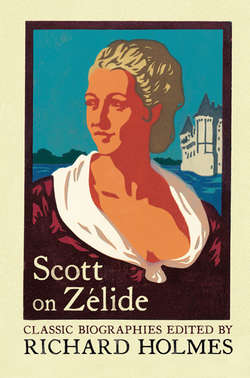Читать книгу Scott on Zélide: Portrait of Zélide by Geoffrey Scott - Richard Holmes - Страница 8
4
ОглавлениеDespite all her determination to direct her own life, Zélide’s destiny was shaped and influenced by four very different men. The first was her older and clandestine correspondent the Chevalier d’Hermenches, a close friend of Voltaire’s, the sophisticated familiar of the Swiss and Paris salons, whose powerful influence – both emotional and literary – lasted until Zélide was over thirty. He was a clever man who understood her very well, but he was also an ambiguous friend, who like Valmont in Les Liaisons Dangereuses, was perhaps ultimately planning to set her up as his mistress. Zélide may have colluded in this, enjoying what she called ‘the salt’ and flattering attention of his witty letters, flirting with him, and co-operating with his mad matrimonial schemes (which seemed perilously like propositions of menage-à-trois). He may eventually have ruined her chances of making a happy and truly fulfilling marriage.
The second figure is one of many, often rather preposterous suitors who fluttered over horizon at Castle Zuylen This was none other than the young Scottish law student, traveller on the Grand Tour, and would-be seducer, James Boswell Esquire. Boswell came to Utrecht in 1763 at the age of twenty-five, shortly after he had first met Dr Johnson in London. He was satisfactorily deep in his own emotional crisis, struggling with manicdepressive episodes, the mania involving sexual adventures and the depression involving drink.
But he was also just discovering his true metier as biographer and autobiographer, and keeping his first secret Journals. Thus the encounter with Zélide struck literary sparks, and ignited one of her best and most outrageous correspondences, with Boswell in the unlikely and ludicrous role of moral tutor. He undoubtedly brought a great deal of fun, charm and frivolity into her life. He eventually proposed marriage to Zélide (by letter) in 1768. She turned him down by return of post: rather exquisitely on strictly literary grounds, since they disagreed on the way to translate a paragraph of his bestselling book about Corsica.
The third was the man she actually married in 1771: to everyone’s surprise and against everyone’s advice, and to the Chevalier’s acute irritation. Zélide had reached the critical age of thirty-one. Her suitor was her younger brother’s tutor, the retiring, stammering, genial, thoughtful, but largely silent and unexpressive Charles de Charrière. He took Zélide away to live on his small country estate of le Pontet, at Colombier on the Swiss border, surrounded by a walled garden, placid vineyards and with a very distant view of the lake of Geneva.
Here the youthful figure of Zélide largely disappears from view. Her childless marriage was accounted, perhaps wrongly, as a disaster. But the person who re-emerges some ten years later, is Zélide transformed into the formidable if disillusioned Madame Isabelle de Charrière, author, moralist and (still) unquenchable letter writer.
Then the fourth, most unexpected and most unaccountable of all the men in her life, appears on the horizon. He was the young, volatile, red-haired French intellectual, Benjamin Constant. Madame de Charrière met him on a rare visit to Paris in 1787. Now the positions were almost exactly reversed from the Zuylen days with the Chevalier d’Hermenches. Benjamin Constant was aged twenty, while Zélide was married, worldly wise and aged forty-seven. Zélide’s influence over her protégé was to last for almost a decade, and produce the last remarkable correspondence of her life. When she was finally supplanted in Benjamin Constant’s affections, it was by the turbulent and Romantic figure of Madame de Staël, and in many ways it killed Zélide.
Yet even after her death, her influence continued to work powerfully on both of them, helping to shape both Benjamin Constant’s autobiographical masterpiece Adolphe (1805), and Madame de Staël’s famous novel of passionate awakenings, Corinne (1807). It was difficult to say whether Zélide (or Madame de Charrière), had in the end failed or succeeded in her life’s plan. Or perhaps it was simply too soon to draw a conclusion.
